Materials | Colours & Dyes | Blue | Red | Yellow | Black or Brown | White & Ivory | Conclusions |
Materials
Carpets and kilims (flatweaves) usually have wool, or occasionally silk, as the fibre forming the pile and the pattern. These are both animal fibres, made of protein, and more expensive than the much more abundant plant materials, like cotton, which are cellulose based. Wool is mostly used also for the foundation of carpets made by nomads and more remote villagers but cotton, the commonest plant fibre, is most often used in rug production of the cottage industry. While cotton bleaches with exposure to sunlight, wool yellows irreversibly. The most abundant natural dye sources were indigo for blue, and madder for red. The third primary colour yellow is sourced in many plants but few were successful.

Colours and Dyes
Blue
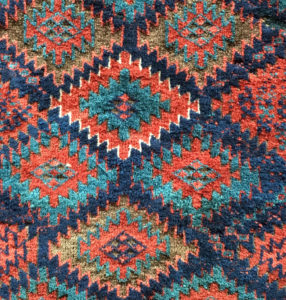
Indigo has been used since at least the 2nd millennium B.C. and is the commonest of all dyes. It is a deep blue substance, or more correctly a mixture of two substances only one of which produces the blue dye, and which is and always has been a chemically processed material. It is known and used in all civilizations, which is remarkable since it is a difficult and complex process to apply it to fibres. The essential colouring ingredient is Indigotin that gives a constant shade of blue varying only in intensity.
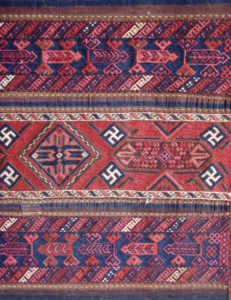
It is widely available from mostly plant sources, particularly of the Indigofera species.The method of fixing the dye to woollen yarn was known as ‘vat dyeing’; a process whereby a paste of the plant leaves is reduced by alkaline fermentation, traditionally wood ash and sheep’s urine. The colour itself does not occur in the plant and the yarn is steeped in the vat of this essentially colourless reduced liquid and on withdrawal from the vat and exposure to air, it oxidises and turns blue. To obtain a deeper shade the process is repeated.
Indigo is not soluble in water and very fast to light. It is a cumulative dye which fixes to the outside of the fibre and can be abrased or rubbed off certain materials – particularly cotton, as the knees of your old jeans will testify! Fixation with wool is much more successful. Indigo dyeing is a labour intensive and difficult process that requires the services of specialist dyers in many traditional societies.
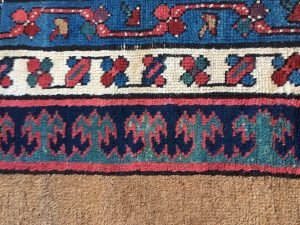
Indigo, when dissolved in sulphuric acid, is converted into its disulfonic acid giving rise to a lighter blue green, water soluble dye. It is a dye that appears to have been used in Agra carpets from India and some Turkish rugs around the middle of 19th century until about 1900. Unfortunately it has a propensity to run and is not as fast to washing as its insoluble parent. However, all known greens in old oriental rugs are achieved by double dyeing Indigo yarn with a yellow dye.
The name Indigo derives from the sub continent of India where its use was probably developed and which exported both the dye and dyed textiles to many parts of the world. The Indigo dyers are easily recognised, as their forearms to the elbows are often black blue. Synthetic Indigo, which has largely replaced natural Indigo produced by the fermentation process, is virtually identical and visually indistinguishable from the natural product. This is because even natural Indigo has very few impurities.
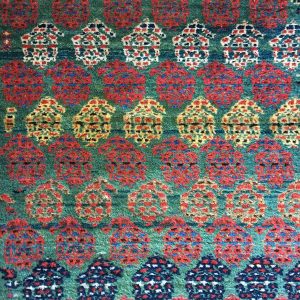
No other blue has been significantly used in rugs, even after the advent of synthetics, but a closely related substance is Tyrian purple, obtained from the glands of molluscs (Murex brandaris). It was highly valued in antiquity, not least because of the huge numbers of shellfish that had to be collected to get a useful amount of dye, and garments dyed with it were extremely expensive. It has, however, never been discovered in any oriental rugs.
Red
“Sleep, sleep my darling, when you travel you will ride a red camel. At the wedding you will wear a red dress, sleep sleep my dearest … .”
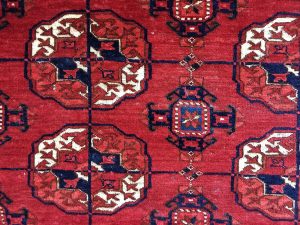
The lines of this Turkmen lullaby reflect the affection Central Asian nomadic tribes had for the colour red. Despite the love of red and its symbolic significance, there are pragmatic reasons as to why the colour red dominated in Turkmen and other Central Asian rugs and textiles. Most significantly, it was the ready availability of the plant madder, the most common natural source for various shades of red.
Madder Rubia tinctorum is a cultivated plant whose wild ancestors are not known. It was grown widely throughout Europe and Asia and is closely related to other red producing dyes, cochineal (Mexico and the new world) and lac (India) sourced from the crushed and dried bodies of plant-eating insects or their resinous exudates. All such dyes are obtained as complex mixtures of substances of similar chemical structures (anthraquinones) and colours.
All these red dyes are water-soluble, so they have to be chemically fixed to the fibre. They are applied with a mordant that both enhances the colour and binds it to the fabric. A mordant is a metallic salt that reacts chemically with both dye and yarn. Depending on the metal in this mordant, the resultant colour of any individual dye can vary considerably in its shade of red. The most widely used in traditional oriental rug production are aluminium (alum) and iron (iron oxide) as the water-soluble salt. The use of madder and the discovery in Europe of alum, which produces such spectacular reds, is heralded as a major reason for the flowering of the arts and the advent of the Renaissance.
In mordant dyeing, the dyer has much more control than with vat dyeing and can manipulate the desired colour or shade through the use of different mordants or the mixing of mordants. For instance, by using a very iron rich mordant a deep purple brown is obtained, whilst at the other end of the scale a salt of aluminium yields a bright orange red. However, madder is a very variable plant both genetically and in its method of cultivation. Plants that are genetically different and grown on different soils in different climates produce considerable variations in colour. The age of the plant also plays an important part. So experience and local knowledge in such cases were critical.
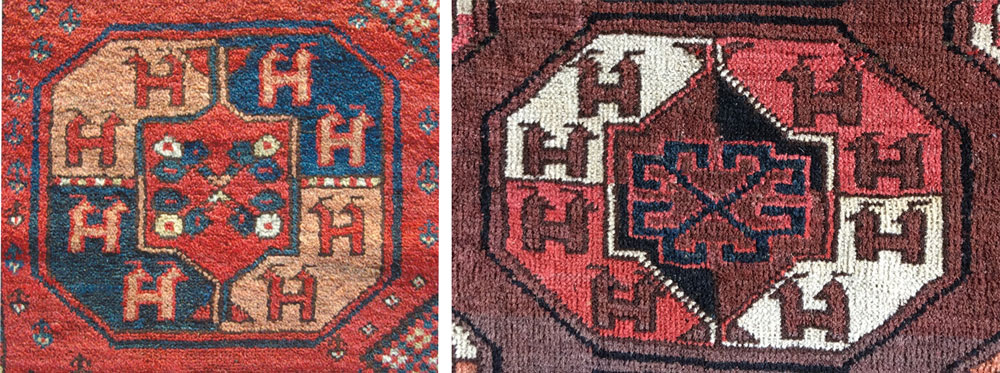
In the dyeing process the yarn was first treated with the alkali (mordant) before adding the madder paste made by extracting the anthraquinone dyestuffs from the madder root. Wool dyed with madder is fast to light, water, abrasion and alkali. It is, however, turned a nasty yellow by acid. N.B. Be careful your kitty cat does not vomit on your prized old Turkmen carpet!
Two other widely used sources of red in old rugs were the insect dyes, lac and cochineal, which give a bluish red and are visually indistinguishable. The cochineal insect lives on the nopal cactus so it appears that dyestuff must have been imported into Central Asia from the Mexico or more likely the Canary Islands, an important source in the 19th century. In early Turkmen weavings, mainly tent and animal trappings, cochineal was used very sparingly to highlight small details in design. Towards the end of the 19th century, it became more accessible and presumably less expensive. It was then used extensively in many areas, particularly in the Persian towns of Kashan and Kirman where there was a burgeoning urban workshop production. The important chemical constituent of cochineal is carminic acid, probably used with an alum mordant. Lac, which was used in much the same manner as cochineal by Turkmen tribes, is an earlier dye typically found in classical Persian and Indian carpets of the 16th and 17th centuries. It is obtained from the Indian beetle from which our shellac furniture finish is obtained, the active constituent being laccaic acid.
Yellow
The availability of a good lightfast yellow gives rise to a spectacular palette when combined with the other primary colours.
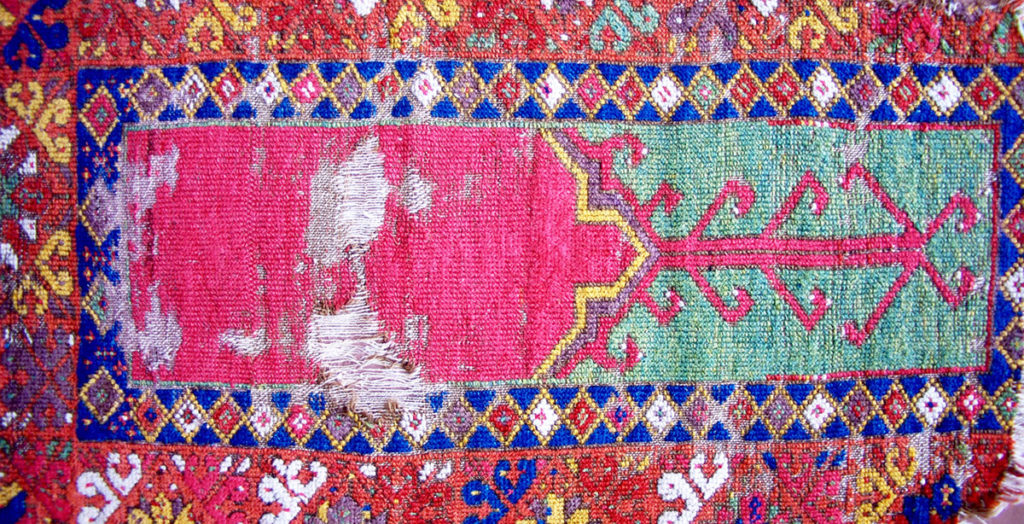
The constituents for yellow are present in many plants and the dyer often turned to the best local source. Nevertheless, good light fast yellows were difficult to obtain. All yellow dyes found in oriental carpets are flavonoids, chemical constituents present in almost all plants. These flavonoid dyes divide chemically into flavones and flavanols of which the flavone group contains by far the better lightfast dyes.
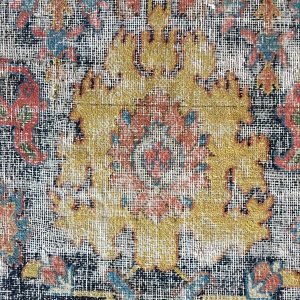
Weld, Reseda luteola, a flavone, is the most widely used and successful yellow producing dye plant in the rug world. It is the dye of 16th and 17th century Persian carpets and is a cultivated plant in Persia, producing and marvellous golden yellow.
Weld also grows wild in Turkey around the Mediterranean coast but not on the Anatolian plateau. This would no doubt also explain its presence in old Ushak carpets of the 16th and 17th centuries from western Turkey. It is probably the dye of rug types from the southwest corner of Turkey, such Melas and Megri, which feature beautiful yellows. On the other hand many areas of Anatolia feature a good number of yellow-producing plants also containing flavones.
Buckthorn, Rhamnus petiolaris, was a plant commonly cultivated in central Anatolia until the 20th century and gave a light-fast yellow on alum mordant. Quercitin, the most commonly available yellow dye, is a major constituent of Buckthorn and is also present in at least twenty other dye-producing plants from the area.
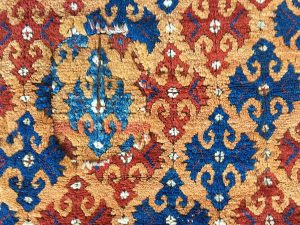
Isparuk, Delphinium sulphureum, a plant found wild in Afghanistan, produces a pale yellow found in old Turkmen rugs and trappings particularly those of the Ersari tribe. Isparuk is a flavanol and has relatively poor light fastness. It is a mordant dye and could be mixed in the same dye bath as madder (one operation) or in a separate process with Indigo to produce a green. In rugs where such green was used, the yellow component gradually disappears with constant exposure to light and the overall shade will revert towards blue.
Apart from the flavonoids the only yellow dye generally mentioned in the rug literature is crocin, the familiar brilliant yellow obtained from the stamens of the saffron plant. This is completely different chemically from the flavanoids and is more similar to the carotenoids, the colouring matter of carrots and the red of cooked shellfish. It is hard to see it lasting long as a dye because of its water solubility and chemical reactivity not to mention its horrendous cost. The term “saffron yellow” should be viewed with considerable scepticism.
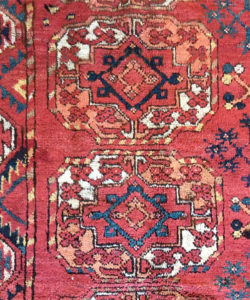
Black or Brown
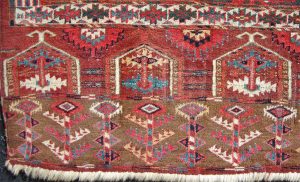
Blacks and browns are important colours that serve often to outline elements of design in old rugs. In old Turkmen weavings, with the exception of some weavings from the Yomud tribe, this was achieved with the use of undyed brown wool that will often stand raised above adjacent areas of pile of different colour. This happens probably because the dyeing process has not affected the strength or resilience of the undyed fibre. The undyed brown wool though does tend to fade in light. Undyed camel hair was also used, predominantly in old Baluch rugs and trappings.
In other rug weaving areas, the blacks and browns are, in the main, obtained from the tannin in seed husks or bark that is then fixed to the yarn with a very iron-rich mordant. This dyeing process, as many people will have observed, renders the wool sensitive to light and causes the pile to corrode, leaving the rug’s pile with an embossed effect.
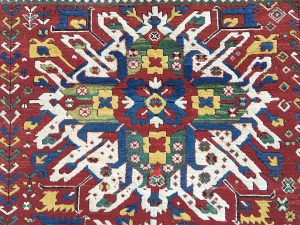
There is in fact no true black found in rugs, only very deep browns or a very dark blue. Mixing a madder red with indigo and a good yellow dye should give a true black but for some reason this process has never been established in any rug weaving, possibly because the process was expensive and too arduous.
White and Ivory
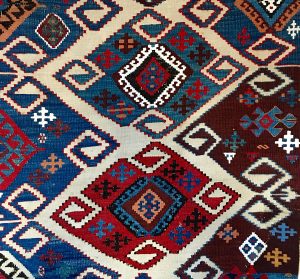
Undyed wool and cotton also feature in both pile rugs and flatweaves. Undyed wool is never a brilliant white but an ivory colour, quite often with a reddish or greenish tinge. A clear white was achieved by bleaching the yarn.
A brilliant white as seen most often in early Anatolian kilims, however, was achieved through the use of white cotton that tends to whiten further with age. A brilliant white tends to make other less vibrant colours recede into the background.
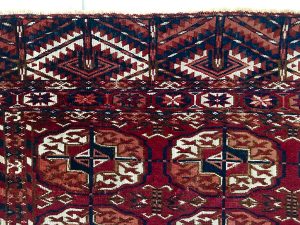
Conclusions
How does knowledge of dyeing and dye sources further our understanding of rugs and contribute to rug scholarship?
Firstly, knowing when certain dyestuffs were introduced is useful in the dating of rugs. We have a well-documented history on the introduction of synthetic dyes but establishing a chronology of natural dyeing is more difficult. Dye testing is an important way forward.
Secondly, knowledge of where certain dyes sources were available can assist in the geographical attribution of rugs. In this instance, yellows are important because dyers often turned to local sources, which were many and varied and chemically identifiable in the case of the more successful yellows. Indigo and madder, because they were often imported, were more difficult to pin down geographically.
